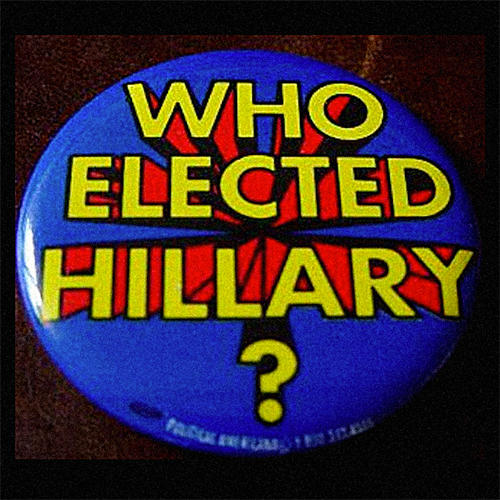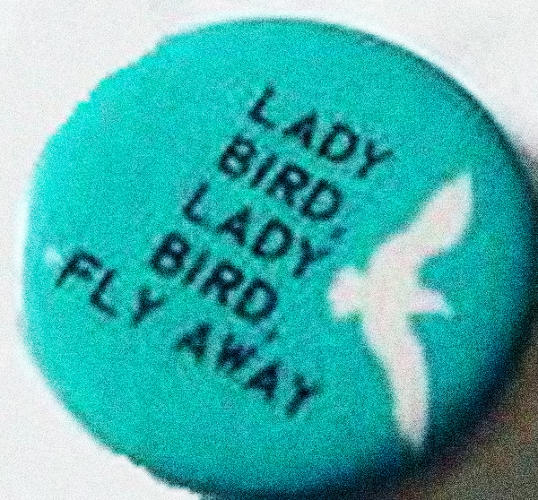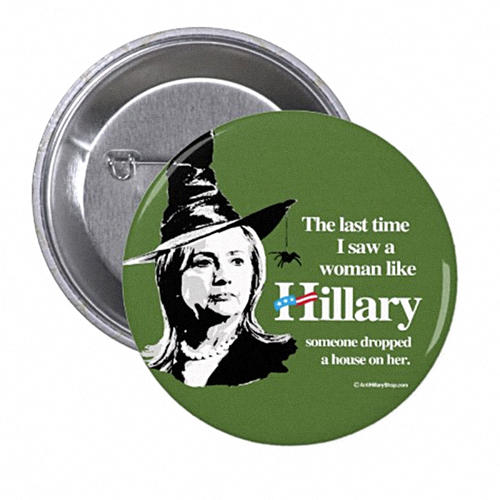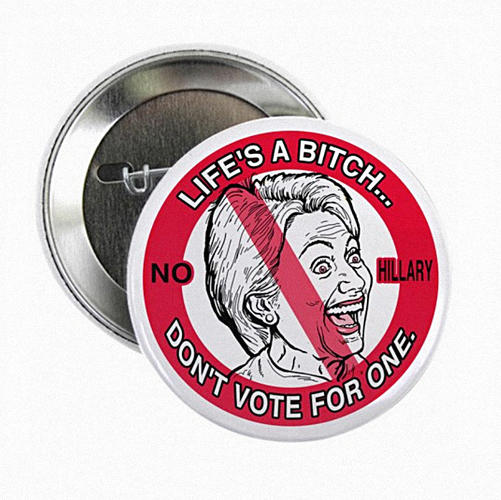The (Not So Secret) History Of Sexist Political Campaign Buttons
In 2013, campaign buttons comparing Hillary Clinton to fried chicken hit the concession stands at the California Republican Party Convention. “KFC Hillary Special,” they announced. “2 fat thighs, 2 small breasts, …left wing.” This was three years before this election, and long before Clinton officially announced her candidacy.
When a journalist tweeted a picture of the KFC button, Republican party officials quickly apologized and removed the vendor selling them from the premises. But they couldn’t stop other people from selling equally offensive buttons, which continued to pop up like whack-a-moles at each of the following conventions.
The offensive KFC slogan isn’t exceptional. There’s been a cottage industry of creating anti-Hillary buttons ever since it became clear she was gunning for the presidency. Unsurprisingly, they often trade in sexism, with slogans highlighting the fact that she is a woman: “Life’s a bitch, so don’t vote for one,” “Hillary sucks, but not as well as Monica,” and “The last time I saw a woman like Hillary, someone dropped a house on her.”

E-commerce sites like CafePress and Zazzle can turn around customized buttons for as little as $1.49 a pop in a matter of days, making it easy for anyone to come up with an attention-grabbing slogan, slap it on a button and sell it at, say, a Donald Trump rally. This cheap button-making technology sparked a resurgence in campaign buttons at a time when they would have otherwise been obsolete. After all, buttons are a very old form of political paraphernalia.
Michael Allen, a historian at the University of Washington Tacoma, says that political buttons are a uniquely American innovation. They first entered the scene during Andrew Jackson’s election campaign in 1824 and were an instant hit. Everybody wanted to get their hands on one to show their allegiance to a particular candidate or party. They were a fun form of political engagement, like “parades, drinking parties and barbeques, songs, banners,” he says. And they were a kind of personal branding, much like we now use Facebook and Twitter to assert our political identities.
The very first buttons were so expensive to make that they “more closely resembled jewelry and formal fashion accessories than what would become the modern political button, a product of postbellum American technological innovation,” he says. But with cheaper materials — particularly the invention of celluloid in 1868 — buttons quickly became accessible to the masses.
And with these mass-produced buttons came slogans that attacked women, long before women were running for public office. Since the early 20th century, there have been buttons disparaging the wives of the men running for president. The slogans were designed to besmirch the candidates, but possibly also stir up anxiety that a strong woman might have too much influence in the White House.
“Gender roles are associated with institutions: the family, the workplace, the military or in this case, the government,” Eileen McDonagh, a political scientist at Northeastern University points out. “Sexism often emerges out of a sense that women’s changing behavior may threaten the very foundation of those institutions.”
In 1932, when Franklin Roosevelt was running for president, buttons began to show up that said “We Don’t Want Eleanor Either”. Another said, “Eleanor? No Soap!” which was a colloquial way of saying, “No way!”

In 1964, when Lyndon Johnson was running for office, there were buttons asking Lady Bird Johnson to fly away.

And of course, when Bill Clinton was in office, the attacks against his wife began, with buttons asking, “Who Elected Hillary?”
While sexism in buttons is not new, there has been a distinct shift in tone in the recent spate of anti-Hillary buttons. The slogans in the past were less vitriolic and hateful than the most recent ones. “They were tamer,” McDonagh says. But she also points out that they were much less personal than the attacks we’re seeing now against Hillary Clinton.

“In the past, there was resistance to the idea that women were stepping out of their roles, but this is very different from what I would call ‘personalized misogyny,'” McDonagh says. “Rather than just hating all women, a few women are targeted; Hillary Clinton is one of them. There’s a hatred that is focused on her as a woman, not just as a person.”
These personal attacks against Hillary Clinton have dovetailed with the rise of Donald Trump, who has been willing to throw out political correctness and make overtly sexist comments about Clinton, accusing her of playing the “women’s card” and bringing up her husband’s infidelities. In fact, people have spotted that very same KFC button on sale at Donald Trump rallies around the country.
But the good news, according to Jennifer Lawless, a professor of political science at American University, is that these buttons tend to represent fringe elements. “There’s no question that there have been sexist products that have been produced in relation to Clinton’s 2016 race,” Lawless says. “But these are not mainstream communications: they are not put out by the campaigns themselves and the percentage of people who wear a button to support or oppose a candidate is in the low single digits.”
Given that campaign buttons are worn by such a small subset of the population, their purpose seems to have changed. They’re not a common way to identify with a particular candidate, since there are other digital channels like Facebook that are much easier ways to articulate your political beliefs. On the other hand, particularly offensive slogans do manage to get noticed, which is perhaps why there’s been a push toward more extreme sexist comments about Clinton. “They do generate news coverage,” Lawless says. “So they are not totally meaningless.”
Related Content: Should Facebook Censor Donald Trump?
There’s been a cottage industry of creating anti-Hillary buttons ever since it became clear she was gunning for the presidency.

But these attacks aren’t new: they began when she was the First Lady.

Sexist attacks against first ladies go all the way to the early 1900s.

In 1932, when Franklin Roosevelt was running for president, buttons began to show up that said “We Don’t Want Eleanor Either”.

It was such a popular slogan that it appeared on many different button designs.

Another said, “Eleanor? No Soap!” which was a colloquial way of saying, “No way!”

In 1964, when Lyndon Johnson was running for office, there were buttons asking Lady Bird Johnson to fly away.

While sexism in buttons is not new, there’s been a distinct shift in tone in the recent spate of anti-Hillary buttons.

The slogans in the past were less vitriolic and hateful than the most recent ones.

“In the past, there was resistance to the idea that women were stepping out of their roles, but this is very different from what I would call “personalized misogyny,”” Eileen McDonagh, a political scientist at Northeastern University points out. “Rather than just hating all women, a few women are targeted; Hillary Clinton is one of them. There’s a hatred that is focused on her as a woman, not just as a person.”

Fast Company , Read Full Story
(80)














